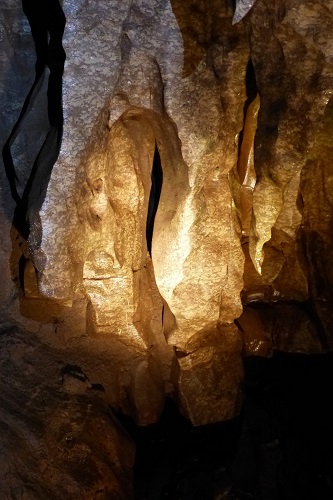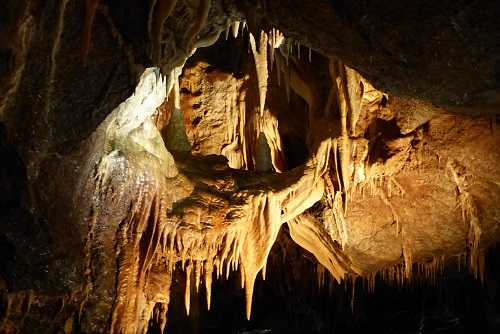Leaving the verdant forest and the warm rain behind, we descended into the cool darkness of the Marble Arch Caves. We followed in the footsteps of Martel and Jameson, the first to explore the cave in the 1800s. They confidently ignored the superstitious locals' warnings about the devils and demons that dwelled within and were well rewarded for their bravery. Like Martel and Jameson, we started our exploration on a boat, following a river through the cave. Unlike them however, we were not in a canvas canoe.

The River-Scoured Rock
Our Boat Trip Through The Marble Arch Caves
Packed tightly in flat-bottomed boats, we motored silently through the Marble Arch Caves. The boat driver carefully navigated us between the overhanging rocks. Two enormous, 15-ton boulders had tumbled down and were wedged precariously between the walls. We passed right underneath them ducking our heads in unison to avoid collision.
Nobody has ever fallen out of these boats but should that happen, there are safety ropes strung along the walls. Whether you would need them when the water, for the most part, is only knee deep, is another matter entirely.
A few minutes later, we disembarked and continued our exploration on foot. While Martel and Jameson would have relied on lanterns and quick-burning magnesium flares, we enjoyed the luxury of electric lighting and our guide, Eoin's torch. He pointed out a few tiny stalactites, the first discernable features we had seen on the otherwise bare rock.

The Fastest Growing Stalactite
Mouldy-looking green and white florets sprouted from the ceiling. These were the very appropriately named 'cave cauliflower' and 'cave brocolli'. They form when bacteria reacts with the rainwater flowing down through the limestone.
At this point in their journey, Martel and Jameson reached what they thought was a dead end and turned back. Years later, equipped with better lights, the Yorkshire Ramblers found a tiny, inconspicuous tunnel and squeezed through. It led to a much prettier part of the Marble Arch Caves. Thankfully, a much larger tunnel has since been drilled through the rock so no squeezing was necessary.
Venturing Deeper Into The Marble Arch Caves
The second part of the cave was magical. We followed a narrow rocky route that weaved between two long, shallow pools. The gleaming towers and spires of the 'Lost City of Atlantis' captured our imagination as we gazed into the crystal-clear water. It turned out to be merely a reflection of the stalactites above.
Like Sirens, reflections like this repeatedly lured us towards the water and we found ourselves teetering at the edge of the path more than once. Thankfully we did manage to keep our feet dry.

Underground Pool
All The Limestone Features In One Place
Looking up, we spotted a hefty stalagmite with a slender stalactite hanging tantalisingly close overhead. This pair are known as the 'engaged couple'. It will be thousands of years however, before the two actually meet. They wait patiently right next to a fully formed column, a reminder of their destiny. With masses of flowstone and long rashers of cave bacon rippling across the ceiling, this part of the Marble Arch Caves has an example of all of the limestone cave features in one tiny area. No need to look anywhere else.

Can You Spot Every Limestone Feature?
It was as we were leaving the caves however, that we saw the most impressive feature, Martel's stalactite. At over 2 metres long, it dwarfed any of the other stalactites we had seen. We could clearly see where the end had been knocked off by vandals. It was repaired by the Ulster Museum who developed a special resin to glue the tip back on. Nobody knows whether the stalactite will continue to grow or not. We were advised to check back in 70 years time.
Marble Arch Caves Tour Tips
Tours of Marble Arch Caves usually last around 75 minutes. It's always 8 - 11oC in the caves so bring a jumper or jacket. You'll be expected to walk about 1.5km and climb 150 steps so wear sensible shoes too.
At peak times, like weekends and school holidays, it's best to book a tour in advance. When we visited in July, the waiting time for those who hadn't booked was around an hour. See the Marble Arch Caves website for more information.
When there is a lot of rain, some parts of the caves are closed to visitors. The boat trip may be cancelled and a shorter tour offered. We found the staff very helpful. They suggested we phone on the morning of our tour to check the conditions in the cave. Had the full tour not been available, they would have helped us to reschedule.

Martel's Giant Stalactite
What Else Is There To Do At Marble Arch Caves?
We followed a boardwalk through the forest, past the entrance to the show cave. The path crossed the top of the Marble Arch, which isn't marble at all but does give the caves their name. We peered down through Maggie's Hole, a sizeable void in the top of the arch. The story is that a young girl fell through the hole and landed in the river below unharmed. We tried to work out whether that was possible and concluded, if the story was true, she must have been very lucky indeed.

Cascades Waterfall
Descending into Cladagh Glen, we followed a gravel path along the banks of a peaty, tea-coloured river. Passing ferns and flowers, we finally made it to Cascades Waterfall, the highlight of our walk. Unlike the busy visitor centre above, there were very few people in the glen. We did encounter a couple of hungry mozzies though.
Is This The Cave From Game Of Thrones?
Yes and no.
This is not the cave we've already seen in Game of Thrones. Beric Dondarrion's Brotherhood Without Banners used nearby Pollnagollum Cave as their hideout. You can see the outside of Pollnagollum Cave from a viewpoint but entry is prohibited.
However, earlier in 2019 the Marble Arch Caves were closed to the public for around 10 days. This allowed access for a film crew working on the prequel to Game of Thrones.
